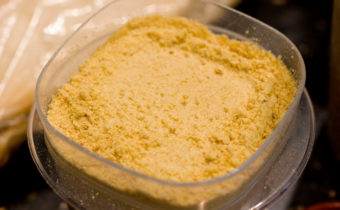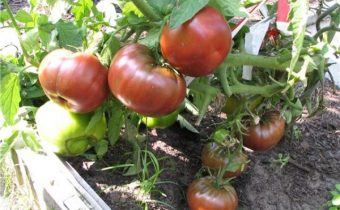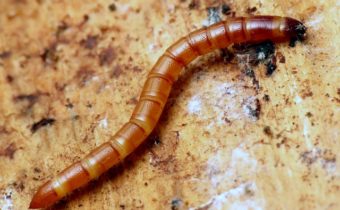Wireworm in a greenhouse with tomatoes, what to do how to fight?
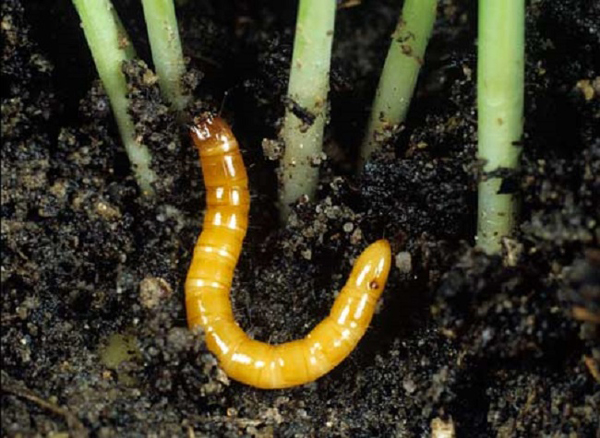
One of the most dangerous pests of tomatoes is the wireworm. So called the larva of the beetle beetle, which lives in the soil and feeds on rhizomes and tubers of garden crops.
The number of ovaries and the size of the fruit on the bush depend on the health of the tomato root system, and if it is significantly damaged, the plant may die. As a result of the activity of the wireworm, the planting yield is reduced several times.
Pest features
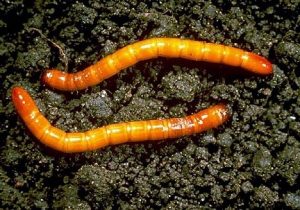 Adult click beetles do not cause direct damage to tomatoes, the larvae are dangerous. Each female lays up to one and a half hundred eggs. Larvae appear after 3-6 weeks, depending on the weather and soil type. The warm and humid microclimate of greenhouses makes the conditions for greenhouse conditions as favorable as possible for the pest.
Adult click beetles do not cause direct damage to tomatoes, the larvae are dangerous. Each female lays up to one and a half hundred eggs. Larvae appear after 3-6 weeks, depending on the weather and soil type. The warm and humid microclimate of greenhouses makes the conditions for greenhouse conditions as favorable as possible for the pest.
Juveniles have an elongated and soft white body. During this period, the larvae are most vulnerable to biological agents. With age, their shell becomes more durable, acquiring orange-brown color. In this phase, insects stay for three years, pupation occurs in the fourth year. Even in conditions of open ground, the larvae are not afraid of winter frosts, climbing into the soil to a depth of half a meter.
The wireworm is greedy, especially dangerous for planting two- and three-year-old larvae. Basically, the pest feeds on the roots, but penetrates the stalk, reaching the shoots and even the flowers of tomatoes. In this case, the larva can reach 5 cm in length, seriously damaging the plant tissue.
In tomato bushes, affected by the wireworm, growth slows down, curls, turn yellow and dry leaves. The rotting of the tissues around the gnawed by the larva moves begins. Plants become more vulnerable to fungal and bacterial diseases.
From the larvae of tomatoes can move to other cultures. Wheat, sunflower, corn and barley, as well as some of the roots - potatoes, beets, carrots, and onions - are affected by the wireworm.
Ways to fight wireworm
Insect excretion is possible only with an integrated approach to the fight, including the treatment of plants and soil with insecticides, the use of traps and agrotechnical techniques.
Agrotechnology in the fight against pest
It is believed that it is almost impossible to expel the wireworm from the site, therefore all agrotechnical measures should be introduced into the permanent plan for the care of the most vulnerable crops. In this way, the pest population is kept to a minimum.
Autumn digging (suitable only for greenhouses with collapsible design).
It is necessary to wait for stable frosts, dig up the soil to a depth of 15-20 cm and immediately after that remove the shelter. The larvae that did not have time to go into the deep layers of the soil, will be on the surface and freeze. But it should be noted that the wireworm survives at temperatures of -2 ... -4 ° C for several days.
Nitrogen supplement
In the framework of the fight against wire, only mineral nitrogen-containing fertilizers are embedded in the soil: ammonium sulfate, ammonium nitrate, and urea. The procedure should be carried out in the spring, before planting tomatoes in the greenhouse. Fertilizers are scattered dry on the surface of the soil and make digging. After this, the beds should be watered.
Selection of "neighbors"
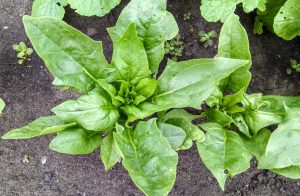 Next to the tomatoes should be planted plants that the wire does not like - legumes, white mustard, radish, spinach, rapeseed. Between the rows you can sow annual flowers - dahlias, phacelia, lupine. From perennials fit clover, alfalfa, sweet clover.
Next to the tomatoes should be planted plants that the wire does not like - legumes, white mustard, radish, spinach, rapeseed. Between the rows you can sow annual flowers - dahlias, phacelia, lupine. From perennials fit clover, alfalfa, sweet clover.
Weeding
Rare loosening in the ground creates a favorable environment for the wireworm.
Weed removal
The wireworm feeds not only on cultivated plants, but also on some weeds, most of all preferring creeping wheat grass. It is necessary to clear the area of weeds, preferably, while removing the grass roots from the ground. Harvested weeds should be burned, since the larvae can be found in their stems.
Wire trap
It is easiest to lure a pest into a trap during a period when the larvae have not yet gone into the ground for the winter, and food is scarce, that is, after the harvest of the tomato crop. After removing the tops and roots from the garden, it is necessary to bury several potato tubers in different planting areas. The depth of the bait is 10-15 cm. These areas should be watered several times to attract more larvae. After 3 days, the potatoes are dug out and burned, and new tubers are placed in the ground in other places.
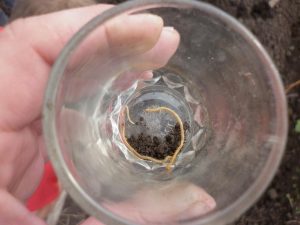 Potatoes can be pierced with a stick or tied to a fishing line to facilitate the extraction procedure. For greater reliability, it is recommended to treat the tubers with poisons that are used to protect potato plantations - Prestige, Celeste, Cruiser, and others.
Potatoes can be pierced with a stick or tied to a fishing line to facilitate the extraction procedure. For greater reliability, it is recommended to treat the tubers with poisons that are used to protect potato plantations - Prestige, Celeste, Cruiser, and others.
Instead of potatoes, you can use beets, carrots, or sow corn or lettuce after harvesting. Plants should be dug before the onset of cold weather, so that the wireworm would not have time to go into the ground. Manure and straw are suitable from non-food baits: spreading them in small groups on beds, in a few days you can find clusters of larvae under them. All traps must be burned.
Despite the fact that the pest loves wet soils, you should not try to “smoke” the larvae, depriving the plants of watering. First, the lack of irrigation will have a negative impact on the volume of harvest and the taste of the fruits of tomatoes. Secondly, the drying of the soil will push the wireworm to move from the roots to the stems, which will only aggravate the situation.
Chemical processing
To resort to processing plantings of tomatoes by chemical means should be only with a large infection with wireworm. It is necessary to choose substances that do not accumulate in the soil and fruits. These include:
| a drug | active substance | mode of application |
| Aktara | thiamethoxam | You can apply in two ways:
1. For spraying the bushes (valid for a month), you need to dilute 1.2 g of the product in 10 liters of water. 2. For watering planting (valid for 1.5 months) use a 0.04% solution of the drug. |
| "Diazinon" | diazinon
|
Plants are watered with a 60% solution at the beginning of the growing season. Provides protection from wireworms for 3 weeks. |
| "Basudin" | A mixture of 1 part of the preparation and 3 parts of sand should be embedded in the soil before planting at the rate of 60 g per 10 m2. The effect lasts for about 6 weeks. | |
| "Provotoks" | For 2-4 g of the funds in a dry form put in the hole before planting seedlings in the greenhouse. | |
| "Force" | tefluthrin | The drug is applied to the soil during spring excavation (15 g per 10 m2). The validity period is about 1.5 months. |
Biological agents
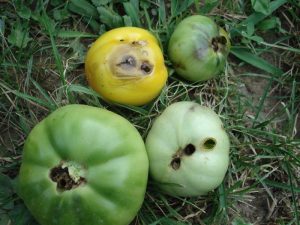 These funds are derived from the tissues of plants after the expiration date and will not poison the crop, if you do not use them during the fruiting period. But all substances are toxic, therefore, during the processing of planting should observe safety measures.
These funds are derived from the tissues of plants after the expiration date and will not poison the crop, if you do not use them during the fruiting period. But all substances are toxic, therefore, during the processing of planting should observe safety measures.
In a greenhouse, in all cases it is recommended, if possible, to give preference to biological preparations over toxic chemicals. To combat wireworm you can use:
- "Nemabakt" - contains bacteria and nematodes, parasitizing on the larvae. Packaging of the drug is diluted in a bucket of water. This volume is enough to handle 1 weave landings.
- "Metarizin" - contains an entomopathogenic fungus that infects a wireworm.In addition, the drug is a peat fertilizer that improves the quality of the soil. Dilute 1 g per liter of water, watering the beds after harvesting 0.5 liters per 5 m2. The procedure is carried out during the autumn or spring digging of the soil.
Folk recipes
"Home remedies" are less effective than specialized drugs, but are suitable for the prevention and control of a small pest population.
- Potassium permanganate Before planting seedlings in the greenhouse in each well, pour 0.5 liters of a pale pink solution of potassium permanganate (about 5 g of powder into a bucket of water).
- Onions or mustard. You can also put in the wells for planting seedlings by a handful of onion peel or half a teaspoon of mustard powder.
- Nettle. 1/2 kg of ground nettle (without seeds) is poured with a bucket of water and left for half a day. After filtering the infusion, water a bed of tomatoes. Nettle can be replaced by dandelion or coltsfoot - 200 g per 10 liters of water. Watering with infusions is allowed 3-5 times per season, but not more than 1 time in 2 weeks.
- Celandine. 100 g of raw materials per 10 liters of water, insist 30 minutes. After the liquid turns brown, you can begin to water.
Prevention
Preventing wireworms is easier than getting rid of the pest. Therefore, when planning planting tomatoes, it is worth considering both the obstacles and the appearance of larvae in the soil.
- Do not neglect the procedure of liming, as well as the introduction of baking powder into the soil - the pest prefers acidic clay or loamy soils. In addition, light soil with neutral acidity is ideal for the cultivation of tomatoes.
In the greenhouse pest, as a rule, falls together with the soil or manure. When updating the soil layer in the shelter, it is necessary to check the new earthen mixture, dig several potato tubers into it for two or three days.
- Organic soil is a good medium for wireworms. It is necessary to limit the introduction of manure into the soil and give preference to the liquid version of the fertilizer.
- In conditions of closed ground, it is difficult to resort to the help of natural wireworm enemies - tits, rooks or starlings. But after harvesting, chickens can be released into the greenhouse; birds will select a part of the larvae.
- Varieties of tomatoes with fruits of pink and burgundy shades, as a rule, are not susceptible to damage by the larvae of the click beetle.
- Do not save space in the greenhouse due to planting density. In such conditions, tomatoes receive insufficient nutrition and light, while the wireworm is primarily dangerous for weakened plants.
Having found wireworms in the ground, one should tune in to a long and painstaking struggle. It is impossible to remove a pest in one season, but after 2-3 years of systematically carried out measures against it, it is possible to achieve a reduction in the insect population to an insignificant number. It is desirable to use all means of struggle, except for chemical treatments, in combination, this will provide a quick and stable result.


